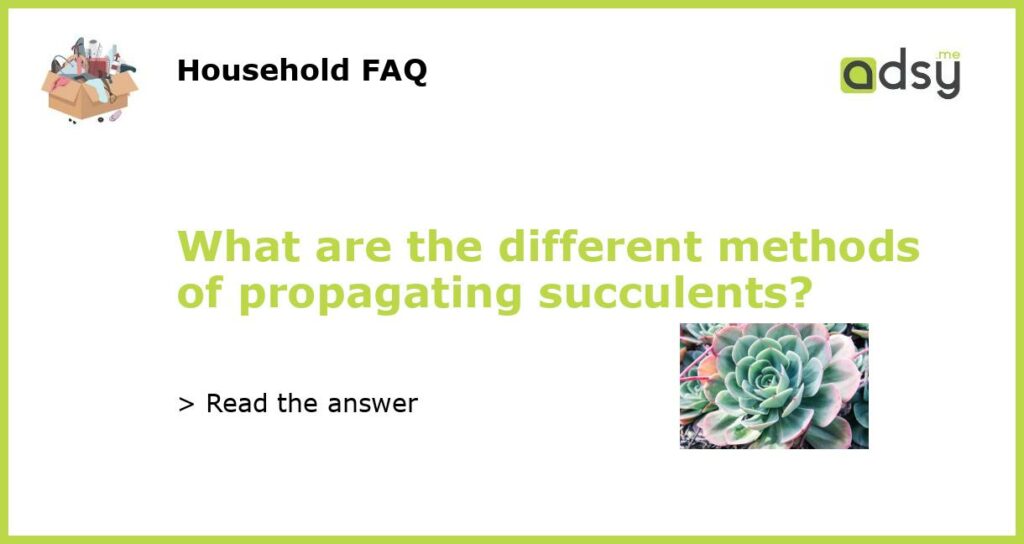Leaf Propagation
One of the most common and easiest methods of propagating succulents is through leaf propagation. This method involves taking a leaf cutting from a mature succulent plant and allowing it to develop roots and eventually grow into a new plant.
To propagate succulents through leaf propagation, simply gently twist or cut a leaf from the stem of the parent plant. It is important to ensure that there is a clean break and that the leaf is intact.
Once you have your leaf cutting, let it dry out and callous for a few days to prevent rot. Then, place the leaf cutting on top of well-draining soil or a bed of succulent soil mix and lightly mist the soil to keep it moist.
Over time, the leaf cutting will start to develop roots from the base and a new plantlet will eventually emerge from the leaf itself. It can take several weeks to months for this process to complete, but with patience and proper care, you can successfully propagate succulents through leaf propagation.
Stem Cutting Propagation
Another method of propagating succulents is through stem cuttings. This method involves taking a section of a mature succulent stem and allowing it to develop roots and grow into a new plant.
To propagate succulents through stem cutting, carefully cut a section of the stem from the parent plant using a clean, sharp knife or shears. Make sure that there are at least a few healthy leaves attached to the stem cutting.
Similar to leaf propagation, let the stem cutting dry out and callous for a few days before planting it in well-draining soil or a succulent soil mix. Water the soil after planting and keep it lightly moist, allowing the cutting to develop roots and grow into a new plant.
Stem cutting propagation can be a bit faster than leaf propagation, as the stem cutting already has some established tissue and is capable of producing roots more quickly.
Division
Division is another method of propagating succulents that is particularly useful for clumping varieties. This method involves separating offsets or “pups” from the parent plant and replanting them to grow into new individual plants.
To propagate succulents through division, carefully remove the parent plant from its container and gently separate the offsets or pups from the main plant. Each offset should have its own set of roots and be able to survive as an independent plant.
Once you have separated the offsets, plant them in individual containers or in a larger pot, making sure to use well-draining soil or a succulent soil mix. Water the soil after planting and keep it lightly moist to encourage establishment.
Division is a great method for increasing your succulent collection or sharing plants with friends and family.
Offsets Propagation
Similar to division, propagation through offsets or “pups” is a method that involves separating and replanting the smaller, self-propagating plants that grow from the base of the parent plant.
To propagate succulents through offsets, carefully remove the parent plant from its container and gently separate the offsets from the main plant. Each offset should have its own set of roots and be able to survive as an independent plant.
Plant each offset in its own container or in a larger pot, ensuring that you use well-draining soil or a succulent soil mix. Water the soil after planting and keep it lightly moist to promote root development and growth.
Offsets propagation can be a quick and effective way to expand your succulent collection and create new plants from the existing ones.
Seed Propagation
The final method of propagating succulents is through seed propagation. This method involves sowing seeds from mature succulent plants and allowing them to germinate and grow into new plants.
Seed propagation requires a bit more patience and care compared to the other methods, as it can take several weeks to months for the seeds to germinate and establish themselves as young plants.
To propagate succulents through seed propagation, collect ripe seeds from mature plants and sow them in well-draining soil or a specific succulent seed mix. Lightly press the seeds into the soil and mist with water to keep them moist.
Place the seeded containers in a warm, well-lit area and keep the soil consistently moist but not waterlogged. Over time, the seeds will germinate and the young plants will start to grow.
Seed propagation can be a fun and rewarding way to grow a variety of succulents, as it allows for the possibility of creating unique hybrids through cross-pollination.






